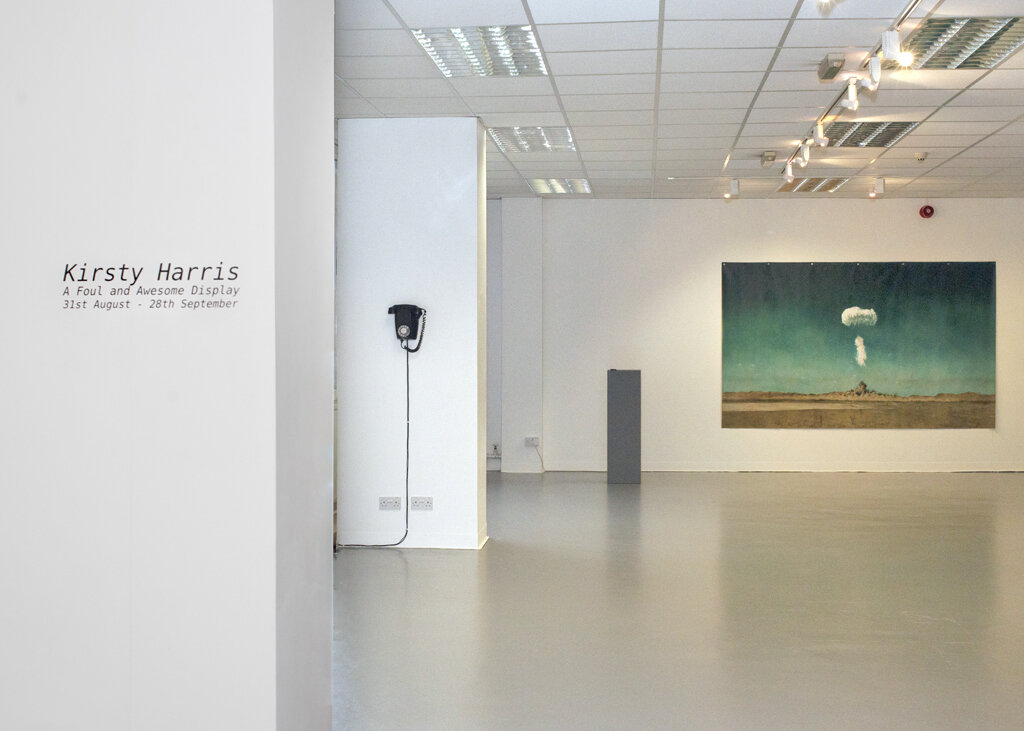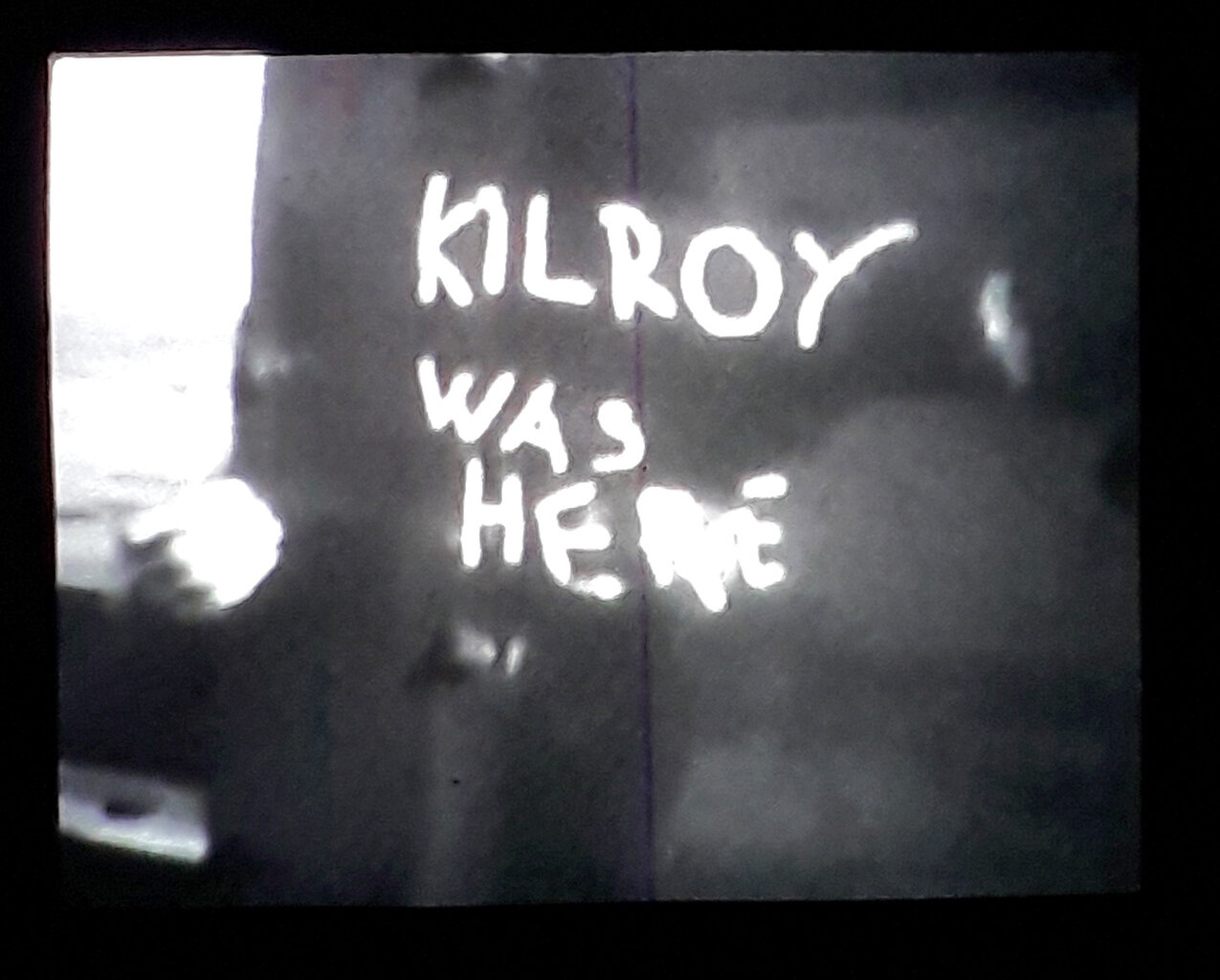A Foul and Awesome Display
Kirsty Harris
31 August – 28 September 2019
Kirsty Harris, Charlie, 2017, oil on unstretched linen, 69x112ins (175x284cm). Photo: Judith Fieldhouse
“I’m interested in the decisive moment, a meditation on a split second. That split second iconically represents our race to self-destruction. The beauty and awe of the landscape, the dust, the glow, the force of the explosion. The myths surrounding the characters in this master-plan to kill ourselves off. The fight for survival. We’ve shown ourselves THE END.”
Harris’s paintings depicting nuclear bomb tests are vast and confrontational, depicting moments of manufactured violence that radically disrupt the landscape. In Charlie (2017) each square inch of linen represents 4 tons of TNT – which in turn is the unit of measurement that denotes the yield of the explosion.
A 1950s rotary telephone rings intermittently and when answered plays the audio piece Cold Call (How I Learned to Stop Worrying 1945-2019) (2019). The composition is a musical account of every officially recorded nuclear explosion. Each different instrument represents a country that partook. Each month in history lasts a second in time. Each note played depicts a single detonation. The piece passes through periods of relative calm building up through chaotic peaks of activity and back down again. Coding and electronics: Abbie Howell and James Allen.
Projections, unavoidable, relentlessly looping, fill the room with moments from films made by the Chinese People’s Liberation Army. In The Victim (2016) a Yak-11 aircraft (potentially gifted to China by the USSR during a time of collaboration) twists and turns like a trapped animal – in the desolate landscape of the Lop Nur Desert. In Prescribed (2019) ‘smiley faced’ equipment jolts up and down alongside a caged monkey, creating the feeling that the room itself is shaking.
The Apple (2016-19) is an instructional artwork, illuminated by a bare bulb from above, it commands you to eat the apple and take a printout from the stack. The Apple references the ‘Father of the Atomic Bomb’, JR Oppenheimer’s attempt to poison his lab tutor at Cambridge University.
In conjunction with the painting Charlie, in the publication entitled Completely er, unfolding itself (2019) Harris has transcribed the first official live television broadcast of an atomic explosion in 1952. The reporters struggle and grasp for the language to describe the mushroom cloud in front of them.
A 12-inch vinyl picture disc, How I Learned to Stop Worrying (1945-2019) (2019), and a Risograph print, Charlie (2019), in a limited edition of 200, are also available to buy during the exhibition. 500 Risograph exhibition posters have been made for the public to take for free.
Kirsty Harris was born in 1978 in Nottinghamshire and raised in Yorkshire. She lives and works in London. She graduated from the Sir John Cass School of Art, London in 2002. Solo exhibitions include ‘How I Learned to Stop Worrying’, CFCCA, Manchester (2016). Group shows include ‘Field Study’, The Auxiliary Warehouse, Middlesbrough, ‘Rules of Freedom’, Collyer Bristow Gallery, London (2019), ‘Strange Love’, Bankley Studios and Gallery, Levenshulme, ‘SOLO Award 2018’, Chiara Williams Contemporary, London, ‘POWERCUT’, SET Project Space, London (2018), ‘Phantom’, Ruskin Gallery, Cambridge, ‘Paradice Lost’, Plymouth Art Weekender (2017), ‘Liberate yourself from my vice-like grip’, Islington Mill, Manchester (2016). Harris had an artist’s residency at Vane, Newcastle upon Tyne in 2015. She co-founded Come Quick Disaster, a platform for art, with Henrietta Armstrong. She is co-curator of ‘WIMMIN II’ coming up in October 2019 as part of Art Licks Weekend. Her work is held in private and public collections internationally including The National Atomic Testing Museum, Nevada, USA.
Artist talk: Kirsty Harris in conversation with Dr Daniel Barnes: Saturday 28 September, 3-4.30pm
Kirsty Harris will talk about her work with Dr Daniel Barnes, philosopher, critic and curator. Barnes has curated a number of group and solo exhibitions, including ‘Strange Love’ in 2018 featuring Kirsty Harris, and he has written widely on art and aesthetics. His book, The Value Industry, exploring the relationship between art and money, is available now from Amazon.
Take a video tour of the exhibition
Share this page
















